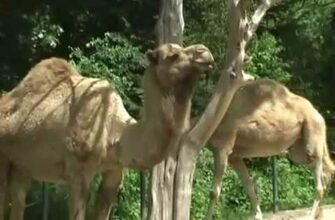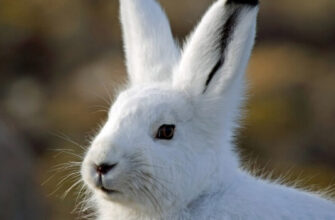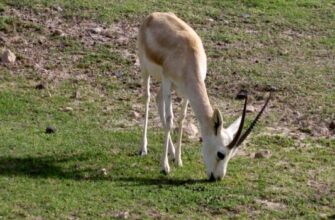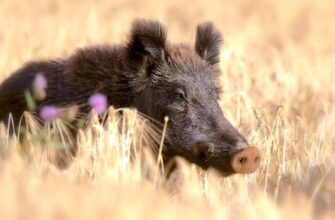The wild manul cat belongs to the kingdom — Animals, type — Chordates, class — Mammals, order — Carnivores, to the — Feline, subfamily — Small cats, genus — Cats.
Weighing between 2.2 and 4.5 kg, this mammal is recognizable by its small body, short legs, thick coat and fluffy tail. The body length of the manul varies from 50 to 65 centimeters, and the length of the tail — from 20 to 30 centimeters.
Origin of the species and description of the manul
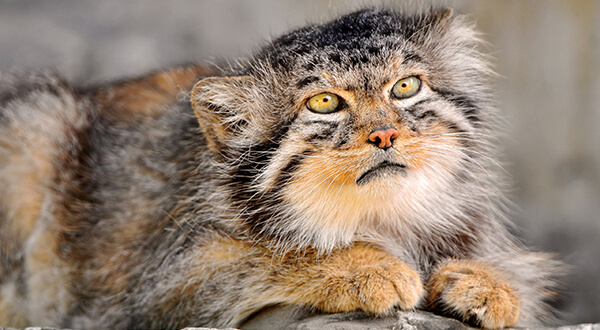
Photo: Cat cat
Early cats may well have been similar to such a modern Madagascar predator as the fossa. These mammals occupy the same niche in the wild as all felines.
About 18 million years ago, modern cats (Felidae) evolved from Schizailurus. The first modern felids were the early cheetahs (Miracinonyx, Acinonyx). It is believed that they appeared about 7 million years ago. Some sources report that the North American cheetah (Miracinonyx) evolved from Acinonyx only 4 million years ago, but recent research by scientists indicates that Miracinonyx was probably the ancestor of both cheetahs and cougars (Puma).

About 12 million years ago, the genus Felis first appeared, from which many of today’s small cats finally evolved. The two first modern Felis species were Martelli’s cat (Felis lunensis†) and Manul (Felis manul). Extinct species of Felis are Felis attica, Felis bituminosa, Felis daggetti, Felis issiodorensis (Issoire lynx), Felis lunensis and Felis vorohuensis. Thus, manuls are the most ancient felines today.
The genera Acinonyx, Felis and Panthera are represented by individuals living today. The classification of some of these modern species is regularly updated and rebuilt as more precursor fossils become available. They provide reliable clues as to who is descended from whom, and at what time many species parted ways.
Appearance and Body Structure
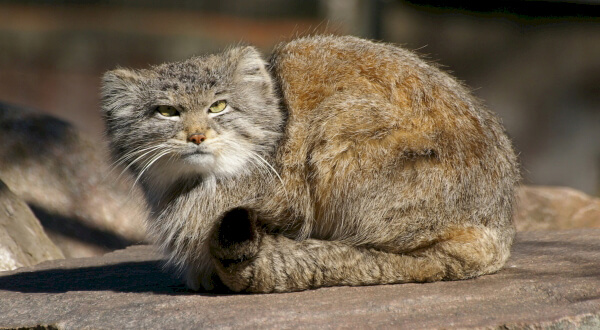
Photo : Manul wild cat
The little manul cat (Felis manul) has a squat body with thick soft fur. The coat color varies from light gray to yellowish brown. The white tips of his fur give the manul a «snowy look». Barely visible stripes are visible on the sides of the body, the head of the Pallas cat is round with black spots on the forehead.
The large eyes are greenish-yellow in color and the pupils constrict into a round shape, unlike most small cats whose pupils constrict into a vertical line when exposed to light. The mammal’s ears are short, rounded, set rather low on the sides of the head. Manul’s legs are short and strong, the tail is thick and drooping down. It is colored with five or six thin rings and has a black tip.

Pallas’ cats look more obese than they really are due to their dense fur. They are well adapted to their Central Asian habitat which is dominated by steppes, cold deserts and rocky terrain. Manul individuals were found at altitudes from 4000 to 4800 meters.
Thick fur protects the body from the cold, and the fluffy tail is often used for warmth. The unique shape of the eyes and the location of the eyelid protect well from cold winds and dust. Manul — a good climber who easily climbs rocks and jumps through crevices. The flat head and low set ears are an evolutionary adaptation for stalking prey in open areas with little vegetation.
Where does the manul cat live?
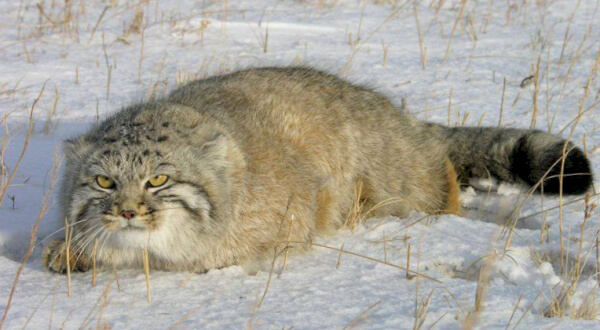
Photo : Steppe cat’s cat
The forest cat manul is found in Central Asia, on the territory of the Caspian Sea, Iran, Afghanistan, Pakistan and northern India. Also, a wild cat lives in central China, Mongolia and southern Russia. The population in the southwestern part of their range — in the Caspian Sea region, Afghanistan and Pakistan — decreases significantly. Manula is almost impossible to meet on the Tibetan plateau. Mongolia and Russia currently make up the majority of their range.
Pallas’s habitat is characterized by an extreme continental climate with low rainfall, low humidity and a wide range of temperatures. They have been found at altitudes up to 4800 m in cold, arid habitats among the steppes and rocky deserts.
These small predators prefer valleys and rocky areas where they have the opportunity to hide, as they avoid completely open habitats. Also, manuls do not like areas with a large snow cover (above 10 cm). 15-20 cm are the limit for this species.
The habitat seems huge for such a small feline. For example, in Mongolia, the average distance between females is 7.4-125 km2 (average 23 km2), while the range between males is 21-207 km2 (average 98 km2). From this we can assume that there are four to eight individuals for every 100 km2.
What does a wild cat eat?
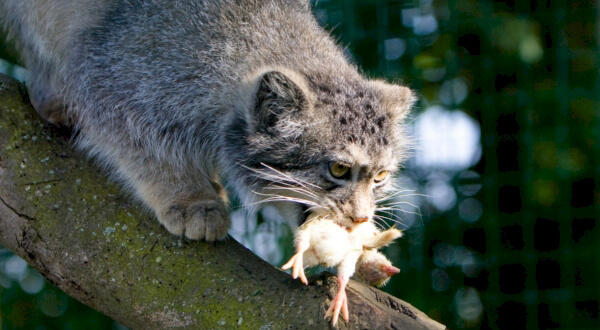
Photo : Wild animal manul
Manul prey is very diverse. The wild cat preys on:
- voles;
- marmots;
- squirrels;
- various birds (including larks, aviaries and partridge);
- insects;
- reptiles;
- scavengers.
The steppe cat manul hides during the day in small abandoned caves that previously belonged to marmots or foxes. Since Pallas are extremely slow, they must position themselves low to the ground and get close to their prey before jumping. In order not to become prey for eagles, wolves, red foxes or dogs, they move with short steps and then hide while eating.
The highest activity in the search for food for Pallas’ cat — it’s dusk and dawn. Also, wild cats can hunt during the day. Other predators such as corsac foxes, red foxes and European badgers rely on the same food sources as the manuls. To avoid competitive exclusion, there is a principle that species that rely on the same resources cannot coexist in the same habitat. Based on this, the cat’s cat adapted the seasonal foraging behavior.
In winter, when there is not enough food, manul actively search for hibernating or frozen insects. Winter — hibernation time for badgers, so wild cats successfully avoid competition for prey.
Character and lifestyle features
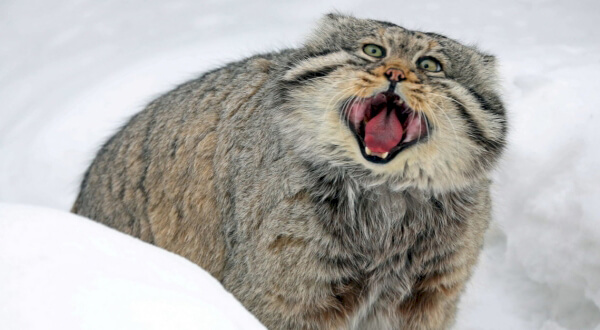
Photo: Pallas cat
Manul has a complex character. The animal is extremely secretive and cautious. Like other representatives of other cat’s manulas — loners. Of all the existing cats in the wild, the manul is the slowest and most incapable of moving fast. Manul, like other predators, loves the night. Despite the fact that this mammal can also hunt during daylight hours, during the day, manuls prefer to sleep. Due to individual characteristics, such as slowness and slowness, the manul often has to guard its prey near the hole. The color of the fur of a wild cat acts as a camouflage.
Manul hides from enemies in gorges, on rocks or in burrows. This cat makes its cozy lair from old badger or fox holes, or adapts in rock crevices and small caves. This is what helps the manul to go unnoticed if he hides. Manul is the slowest among wild cats. When irritated or aggressive, Pallas’ cats make loud noises that have a lot in common with the sounds of an owl.
Social structure and reproduction
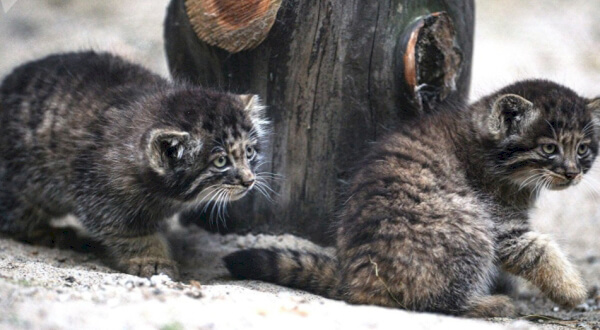
Photo: Cat’s cat
It is believed that the male Pallas roams an area of about 4 km2, but there is no reliable scientific evidence for this. Scientists report that the mating call of the manul sounds like a mixture of the barking of young dogs and the cry of an owl.
Pallas have an annual breeding season. The females of this species are polygamous, which means that a male can mate with several females. The breeding season runs from December to early March, and the gestation period averages 75 days. From 2 to 6 kittens are born at a time. The cubs are born at the end of March and stay with their mother for the first two months.
After the birth of kittens, the male does not take part in the upbringing. As soon as the kittens leave the cattery, they will learn to forage and hunt at the age of 4-5 months. By about 1 year of age, they become mature and can find their partners. The average lifespan of a Pallas’ cat is approximately 27 months, or just over 2 years, due to extreme environmental conditions and a high degree of prey. In captivity, manuls live up to twelve years.
Reasons for the decline in the number of manuls
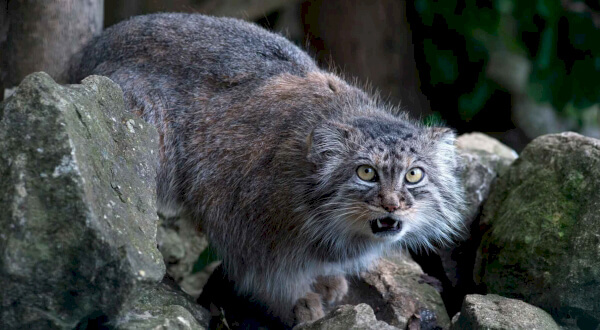
Photo: Wild cat Pallas
The main threats to the manul population are:
- other predators;
- humans.
Manuls exist in nature in small numbers and are poorly adapted to protection from predators. Their dependence on specific habitats makes them extremely vulnerable. The fur of this wild cat is valued in many markets. In the early 1900s, up to 50,000 cats a year were killed for their skins.
Habitat degradation is increasing and affecting the existence of manul. Domestic dogs and human error are responsible for 56% of Pallas’ cat deaths in central Mongolia alone. Cats are sometimes mistakenly killed by hunters, mistaking them for marmots.
The population of Mongolia is threatened by over-hunting and poaching. Manuls are hunted for “domestic purposes”, and it is also possible to obtain permission from local authorities. However, law enforcement is weak and there are no controls. Perhaps the biggest threat to this little cat is the government-mandated poisoning campaigns to control the population of the species that are being carried out on a large scale in Russia and China.
Population status and protection of manuls
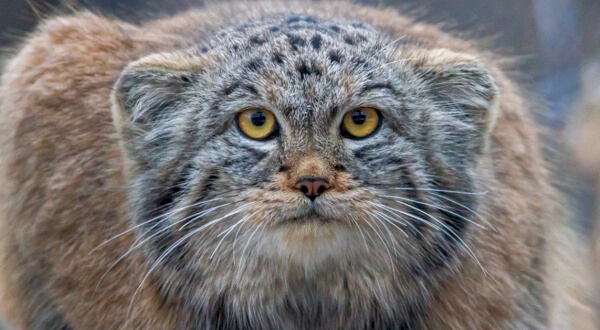
Photo: Manul cat
The Pallas cat has disappeared in recent years from many areas around the Caspian Sea, as well as from the eastern part its original habitat. Pallas’ cat are listed as endangered in the IUCN Red List. The Washington Convention for the Protection of Animals contains guidance on this species in Appendix II.
In 2000, Dr. Bariusha Munktsog of the Mongolian Academy of Sciences and the Irbis Center of Mongolia, together with Meredith Brown, began the first field study of wild manuls. Dr. Munktsog continued to study these cats in central Mongolia and is one of the few researchers who observe the reproduction of females. International Union for the Conservation of Nature Pallas Cat (PICA) — is a new conservation project initiated by North Ark Zoo, the Royal Zoological Society of Scotland and the Snow Leopard Trust. Fondation Segre has also supported the campaign since March 2016.
The PICA mission — Raise global awareness of the Pallas’ cat, build on their natural history and report on the cat’s endangered existence. Increasing the captive population helps to improve the genetic integrity of the species. The best hope for manul — conservationists who, despite the devastation and destruction of their habitat, want to help the wild cat population. Conservation measures should include improving law enforcement and modernizing the hunting permit system.

